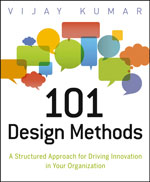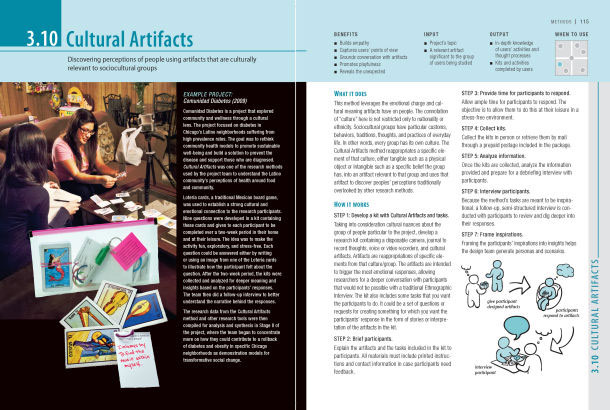 A review of:
A review of:
101 Design Methods: A Structured Approach for Driving Innovation in Your Organization
By Vijay Kumar
Wiley
Today, there are many so-called experts of “disruptive innovation” and “design thinking.” While some of these speakers, consultants, and authors provide useful insights and “actionable assertions” about developing usable, useful, and appealing products and services, others frequently offer nothing more than vague slogans, undefined terms, and simple recommendations that are part of a basic design education in almost every school or university of design.
It is therefore refreshing and encouraging to read Vijay Kumar’s book 101 Design Methods: A Structured Approach for Driving Innovation in Your Organization. He has been working on a compendium of methods derived from his years of teaching at the Illinois Institute of Technology, Institute of Design, where he leads the Strategic Design Planning and the Design Methods Program. As the biography in the book points out, he “has taught, published, consulted, and lectured throughout the world on using structured methods, tools, and frameworks for conceiving reliable human-centered innovations and turning them into strategic plans for organizations.” He has also consulted for numerous Fortune 500 companies. Over the years, I have had the opportunity to follow the development of the book, and I am delighted with the results.
Kumar’s book is about innovation, user experience design, and design thinking. He offers guidelines on how to use design thinking for innovation, but unlike other authors, the book is very through and provides many specifics, including step-by-step instructions and scenarios demonstrating how to apply the techniques described in the book.
The book as a whole is organized into a set of principles required for successful innovation, a model of the design innovation process, and seven modes of the innovation process. Scores of techniques are described for each of the modes along with many useful examples.
Each technique is vividly illustrated and described in terms of what it does and how it works. Small conceptual diagrams help to organize the multitude of techniques and assist the reader in keeping track of the big picture while also learning the details of a particular technique. The book is a practical document, with lots of written and visual information on how-to-do-it and get-it-done.
Kumar’s detailed discussions reflect my own experience with techniques I have used successfully in my own career spanning more than three decades. For example, a chapter on “Interest Groups Discussion” describes a project for the Peapod Labs were it was necessary to obtain input from a target audience of children and parents. He not only explains what it does, but the key factor in achieving good results (active listening). He then describes how it works, including the importance of not only capturing your findings, but reviewing, discussing, summarizing, and sharing the findings with other stakeholders. As with the other techniques described in the book, the benefits, inputs, and outputs for the technique are provided. Also, a simple diagram is used to show when it should be used. It may appear simple and straight- forward, but I assure you, the benefits for each of the techniques, including what it is and how to do it, are not always so obvious.
Another intriguing technique is described in a chapter on “Cultural Artifacts.” This technique helps design innovation teams discover “perceptions of people using artifacts that are culturally relevant to socio-cultural groups.” As an example, he describes a project called “Comunidad Diabetes.” The project was conducted within the Hispanic community in Chicago that is experiencing issues related to obesity and diabetes. He describes the use of “Loteria cards,” a traditional Mexican board game “used to establish a strong cultural and emotional connection to the research participants.” For those not familiar with this particular technique, the descriptions are provided in clear and simple language, not in complex academic terminology, but straight-forward and practical.
To provide an idea of the scope of the book, the following list summarizes a few of the many methods of innovating products and services described within:
- Understanding Society, Culture, and Community Trends
Including: Popular Media Scan, Trends Matrix, and Offering-Activity-Culture Map. - Understanding Context Methods
Including: Contextual Research Plans, Innovation Evolution Maps, and Subject-Matter Experts Interviews. - Understanding People Methods
Including: Field Visits, Ethnographic Interviews, and Cultural Artifacts. - Analyzing & Designing Frameworks of Insights Methods
Including: Observations to Insights, Symmetric & Asymmetric Clustering Matrix, and User Groups Definition - eExplore Concepts Methods
Including: Opportunity Mind Map, Ideation Session, Concept Sketch, Concept Scenarios, and Concept Sorting. - Framing & Designing Potential Solutions Methods
Including: Concept Evaluation, Solution Storyboard, and Solution Prototype. - Delivering Proposed Offerings Methods
Including: Platform Plan, Pilot Development and Testing, and Implementation Plan.
To define all the terms and provide details for more than a few of these techniques is beyond the scope of this review. This summary above should demonstrate that the book is like an illustrated encyclopedia, but contained in only 326 pages. The collection can serve as a way to expand and confirm an understanding of the techniques, to serve as a checklist for a team planning on how to approach a project, or a means of educating business professionals, fellow team members, managers, clients, or customers about what it means to conduct professional product or service development and why it might be more complex and challenging than some might imagine.
101 Design Methods is one of a handful of books available today that enables professionals and practitioners to do a better job. It is good for novices as well as experienced practitioners, managers, and executives. The book also serves admirably as a textbook for teaching. It would not surprise me if it becomes a classic in the field of innovation design.

[bluebox]
Book excerpt: Cultural Artifacts
Cultural Artifacts: Discovering perceptions of people using artifacts that are culturally relevant to sociocultural groups
Example Project: Comunidad Diabetes (2009)
Comunidad Diabetes is a project that explored community and wellness through a cultural lens. The project focused on diabetes in Chicago’s Latino neighborhoods suffering from high prevalence rates. The goal was to rethink community health models to promote sustainable well-being and build a solution to prevent the disease and support those who are diagnosed. Cultural Artifacts was one of the research methods used by the project team to understand the Latino community’s perceptions of health around food and community.
Lotería cards, a traditional Mexican board game, was used to establish a strong cultural and emotional connection to the research participants. Nine questions were developed in a kit containing these cards and given to each participant to be completed over a two-week period in their home and at their leisure. The idea was to make the activity fun, exploratory, and stress-free. Each question could be answered either by writing or using an image from one of the Lotería cards to illustrate how the participant felt about the question. After the two-week period, the kits were collected and analyzed for deeper meaning and insights based on the participants’ responses.
The team then did a follow-up interview to better understand the narrative behind the responses.
The research data from the Cultural Artifacts method and other research tools were then compiled for analysis and synthesis in Stage II of the project, where the team began to concentrate more on how they could contribute to a rollback of diabetes and obesity in specific Chicago neighborhoods as demonstration models for transformative social change.
Benefits
- Builds empathy
- Captures users’ points of view
- Grounds conversation with artifacts
- Promotes playfulness
- Reveals the unexpected
Input
- Project’s topic
- A relevant artifact significant to the group of users being studied
Output
- In-depth knowledge of users’ activities and thought processes
- Kits and activities completed by users
What it does
This method leverages the emotional charge and cultural meaning artifacts have on people. The connotation of “culture” here is not restricted only to nationality or ethnicity. Sociocultural groups have particular customs, behaviors, traditions, thoughts, and practices of everyday life. In other words, every group has its own culture. The Cultural Artifacts method re-appropriates a specific element of that culture, either tangible such as a physical object or intangible such as a specific belief the group has, into an artifact relevant to that group and uses that artifact to discover peoples’ perceptions traditionally overlooked by other research methods.
How it works
STEP 1: Develop a kit with Cultural Artifacts and tasks.
Taking into consideration cultural nuances about the group of people particular to the project, develop a research kit containing a disposable camera, journal to record thoughts, voice or video recorders, and cultural artifacts. Artifacts are reappropriations of specific elements from that culture/group. The artifacts are intended to trigger the most emotional responses, allowing researchers for a deeper conversation with participants that would not be possible with a traditional ethnographic Interview. The kit also includes some tasks that you want the participants to do. It could be a set of questions or requests for creating something for which you want the participants’ response in the form of stories or interpretation of the artifacts in the kit.
STEP 2: Brief participants.
Explain the artifacts and the tasks included in the kit to participants. All materials must include printed instructions and contact information in case participants need feedback.
STEP 3: Provide time for participants to respond.
Allow ample time for participants to respond. The objective is to allow them to do this at their leisure in a stress-free environment.
STEP 4: Collect kits.
Collect the kits in person or retrieve them by mail through a prepaid postage included in the package.
STEP 5: Analyze information.
Once the kits are collected, analyze the information provided and prepare for a debriefing interview with participants.
STEP 6: Interview participants.
Because the method’s tasks are meant to be inspirational, a follow-up, semi-structured interview is conducted with participants to review and dig deeper into their responses.
STEP 7: Frame inspirations.
Framing the participants’ inspirations into insights helps the design team generate personas and scenarios.
Summary of the process
- give participant designed artifacts
- participants respond to artifacts
- interview participant
[/bluebox]
